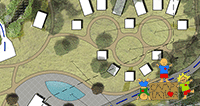|
|
Enjoy Your Summer Evenings with Fewer Mosquitos
Author: Chad Kennedy, Landscape Architect, ASLA
 The rapid retreat of spring's cool morning air and glistening frost is a telltale sign that summer vacations, water balloon fights, baseball games and numerous backyard barbeques are just around the corner. Nothing could possibly break down the mounting anticipation of summer fun and activities, unless, of course if those same activities are attended by literal buzz kills, like mosquitos. A positive outing can quickly turn into a disaster when summer mosquitos surprise attack an unprepared group. With a little forward planning and some intelligent additions to the backyard landscape, maybe these uninvited guests will be forced to find another party to crash, taking any potential diseases with them and leaving behind a worry-free, happy group of people. The rapid retreat of spring's cool morning air and glistening frost is a telltale sign that summer vacations, water balloon fights, baseball games and numerous backyard barbeques are just around the corner. Nothing could possibly break down the mounting anticipation of summer fun and activities, unless, of course if those same activities are attended by literal buzz kills, like mosquitos. A positive outing can quickly turn into a disaster when summer mosquitos surprise attack an unprepared group. With a little forward planning and some intelligent additions to the backyard landscape, maybe these uninvited guests will be forced to find another party to crash, taking any potential diseases with them and leaving behind a worry-free, happy group of people.
Historical Use of Plants as Deterents
Plants generate natural deterrents, repellants, toxins and regulators as defense and protection mechanisms. Many of these are effective against biting diptera and mosquitos. Throughout history societies around the globe have had no choice but to use naturally growing and available plants in a variety of ways to kill and fend off unwanted insects, particularly mosquitos. There are ancient references from Greece, Egypt, Rome, India and other societies to plants being burned, hung in doorways and windows and rubbed on skin to deter insects.2 Many societies exploited plant deterrent qualities by hanging bruised plants near gathering areas, burning crude products made from plant materials and rubbing oils on skin and clothes. Even today plants are used in these ways near rural communities and in the tropics due to availability and cost associated with other chemical options.3 In modern cultures, plant derived burn coils, lotions and essential oils are gaining in popularity and are commonly available.
Research Basis 
It is important to note that most modern research around plant derived deterrents is geared toward vapor toxicity and oil applications. Many studies show that essential oils can be extremely effective, however, they lack longevity and effectiveness of chemical applications.1,3,6,7 Research focused on simple addition of plants to the landscape is scarce. In fact what research that is available suggest that with a few exceptions, plant secretions or plant damage needs to occur in order to release vapors or scents that will deter insects. This being said, the availability of plants in the landscape for use as a rub-on ointment, burned as incense or cut / bruised to release scents may be a useful deterrent. The results of one study show that certain plants can be used in pots or planted near gathering areas and can be an effective methods of control. These are discussed further in the next section.5
Plant Selections with Mosquito Fighting Properties
The plants listed below are shown to have properties that deter mosquitos in one form or another. Some have been tested more than others. The effectiveness of each plant will be limited to how it is used. The list below is compiled from many research articles, but needs further investigation and trials in real landscape scenarios. The repellency effectiveness is not available for all plants.
Lemon Eucalyptus................48-100% repellency when planted in close proximity, burned or applied topically.3 Lemon Bush (Lippia spp)....25-100% repellency when planted in close proximity (33%) or applied topically.3,5 Lantana camara...................27-95% repellency when planted in close proximity (32%) or applied topically.3,5 Thymus vulgaris.....................85-100% repellency when burned or applied topically.3 Lime Basil (Ocimum).............37-100% repellency when planted in close proximity (40%), burned or applied topically.3,5 Ageratum...............................Contains Coumarin which is commonly used in mosquito repellents. No data about effectiveness in the landscape is available other than its use in burned or oil forms.8,9 Lemon Grass (Cymbopogon)...Contains citronella oil that is used in mosquito repellents. Though commonly accepted as a deterrent, no data about effectiveness in the landscape is available other than its use in burned or oil forms.8,9 Catnip...................................Studies have shown that catnip oil is one of the most effective deterrents of mosquitos, ten (10) times more effective than DEET in fact. The study was performed with oil however and, though commonly accepted, no studies show how effective the plant is on its own in the landscape.7.8,9 Other plants commonly accepted as mosquito combating plants, though not tested include, Bee Balm, the Cadaga Tree, Horsemint, Marigolds, Catmint, Clove, Garlic, Lavender, Lemon Balm, Lemon Scented Geranium, Lemon Thyme, Lemon Verbena, Allium, Rosemary and Snowbrush.8,9
Though not a great deal of research has been done with these plants (when used as landscape features) to prove their potency and effectiveness for repelling insects, the fact is, there are many beautiful plants which have an added potential benefit of dissuading mosquitos from disturbing gardens and landscapes where people congregate. With nothing to lose, it is probably worth a try to test some of these plants in the garden and see for yourself if your summer evenings are any more enjoyable. Though not the focus of this article, there are other ways to minimize the number of mosquitos in your garden such as eliminating standing water, irrigating only as much as necessary and encouraging habitat for beneficial insects and creatures that feed on them. Visit our website to read additional articles about other facets of landscape architecture.
1. Fradin, Mark and John Day. "Comparative Efficacy of Insect Repellents against Mosquito Bites." South Pacific Underwater Medicine Society (SPUMS) 33. No. 2, 2003: 103-104
2. Lenglet, Annick, and Sarah Moore. "An Overview of Plants Used as Insects Repellents." Traditional Medicinal Plants and Malaria. Ed. Addae-Kyereme, Jonathan, et al. Google Books. n.p., n.d. Web. 26 Apr. 2015.
3. Maia, Marta and Sarah Moore. "Plant-Based insect repellents: a review of their efficacy, development and testing." Malaria Journal 10(Suppl 1) 2011.
4. Rajkumar, S and A. Jebanesan. "Repellent activity of selected plant essential oils against the malarial fever mosquito Anopheles stephensi." Tropical Biomedicine 24(2) 2007: 71-75
5. Seyoum, Aklilu, Et al. "Repellency of Live Potted Plants Against Anopheles Gambiae From Human Baits in Semi-Field Experimental Huts." Am. J. Trop. Med. Hyg., 67(2), 2002, pp. 191–195
6. Tawatsin, Apiwat, et al. "Repellency of Volatile Oils from Plants against Three Mosquito Vectors." Journal of Vector Ecology, Vol. 26, No. 1: 76-82
7. Zhu, Junwei, et al. "Adult Repellency and Larvicidal Activity of Five Plant Essential Oils Against Mosquitoes." Journal of the American Mosquito Control Association. 22(3) 2006: 515-522.
8. "5 Easy to Grow Mosquito-Repelling Plants." Eartheasy.com. n.p., n.d. 05 Apr. 2011. Web. 20 Apr. 2015. http://eartheasy.com/blog/2011/04/5-easy-to-grow-mosquito-repelling-plants/
9. "31 Plants that Repel Mosquitoes." bestplants.com, n.p., n.d. Web. 20 Apr. 2015. http://bestplants.com/plants-that-repel-mosquitoes/
|
|
|
|
 The rapid retreat of spring's cool morning air and glistening frost is a telltale sign that summer vacations, water balloon fights, baseball games and numerous backyard barbeques are just around the corner. Nothing could possibly break down the mounting anticipation of summer fun and activities, unless, of course if those same activities are attended by literal buzz kills, like mosquitos. A positive outing can quickly turn into a disaster when summer mosquitos surprise attack an unprepared group. With a little forward planning and some intelligent additions to the backyard landscape, maybe these uninvited guests will be forced to find another party to crash, taking any potential diseases with them and leaving behind a worry-free, happy group of people.
The rapid retreat of spring's cool morning air and glistening frost is a telltale sign that summer vacations, water balloon fights, baseball games and numerous backyard barbeques are just around the corner. Nothing could possibly break down the mounting anticipation of summer fun and activities, unless, of course if those same activities are attended by literal buzz kills, like mosquitos. A positive outing can quickly turn into a disaster when summer mosquitos surprise attack an unprepared group. With a little forward planning and some intelligent additions to the backyard landscape, maybe these uninvited guests will be forced to find another party to crash, taking any potential diseases with them and leaving behind a worry-free, happy group of people.
 The California Association of Recreation and Park Districts will present the Cordova Recreation and Park District with the Outstanding New Facility (Large District)Award for Sunridge Park which was designed by O'Dell Engineering and completed in the summer of 2014. The award ceremony will be held at the CARPD Conference Banquet on Saturday May 16, 2015 at the Lake Tahoe Resort Hotel.
The California Association of Recreation and Park Districts will present the Cordova Recreation and Park District with the Outstanding New Facility (Large District)Award for Sunridge Park which was designed by O'Dell Engineering and completed in the summer of 2014. The award ceremony will be held at the CARPD Conference Banquet on Saturday May 16, 2015 at the Lake Tahoe Resort Hotel.